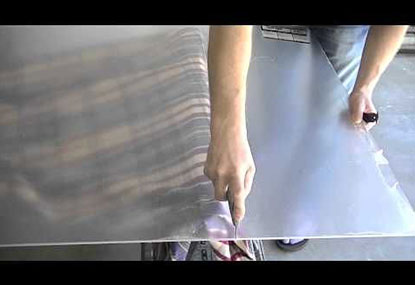Cutting acrylic sheets is quite simple. You can utilise the scoring approach if your sheet is quite thin—less than 3/16 inch (0.48 cm). Otherwise, you’ll have to cut it with a saw. Before undertaking any kind of cutting, put on safety glasses and ear plugs if you’re using an electric saw.


Cutting a Straight Line by Scoring the Acrylic
Step 1: Set the acrylic on a flat surface: Find a flat surface large enough to accommodate your plastic sheet to make it easier to work with. The floor, on the other hand, cannot be used since an edge is required to break the acrylic over later.
Step 2: Draw a line on the sand. Decide where you’ll cut the acrylic first. To make a straight line, measure it out and use a ruler. You can use a permanent marker or grease pencil to draw the line, or you can simply use the ruler to guide your blade.
Step 3: With a plastic scoring blade, score the line in the acrylic. Run a plastic scoring blade along the cutting line, using your ruler as a guide, striving to form one continuous line with mild, steady pressure. Along the line, pull the blade towards you. It’s especially vital to get a straight line on the initial go-around because it will serve as a guide for your subsequent lines.
Step 4: Using the scoring blade, deepen the cut. Run the blade over the line multiple times until a deep groove forms. Flip it over and draw a line down the backside that matches the line on the opposite side. It’s also worth noting that you can score it multiple times.
Step 5: The acrylic sheet should be broken. Place the line you’ve drawn directly along the table’s edge. The technique is made easier by using clamps to hold the sheet to the table. By quickly pressing down on the outer border of the sheet at the scored line, the sheet will break. Wrap your hand around one of the edges and push down with your body weight.
Sawing Acrylic
- Use an acrylic-specific blade. A blade with a high tooth count is required for cutting plastic. Look for a blade that says “acrylic” on it. With these blades, you’ll get a significantly cleaner cut. A standard blade can be used, although the cut will be more jagged.
- Mark the area you wish to cut using a permanent marker before you begin. A straight line can be cut with a circle saw, table saw, or blade saw. You can cut curves using a jigsaw. If required, use a straight edge. When using a jigsaw, masking tape across your cut line might help you get a cleaner edge.
- For a straight cut, feed the acrylic through a table saw. Begin at one of the edges of the mark you just formed. Push the acrylic through the table saw at a steady rate, keeping your fingertips clear of the blades. You don’t want to go too quickly since it will result in a harsher edge, but you also don’t want to move too slowly because the plastic will melt.
- Using a jigsaw, cut a curved line. Place the acrylic glass between two beams so you may cut it with the jigsaw. To maintain your eye on the blade and the line, push the jigsaw from the outer edge towards your body following the line you made. If you get stuck at an angle, turn the jigsaw around and cut from the opposite edge.
Sanding the Edges
- Using a metal file, smooth off any sharp burrs. Examine the edge for any large bits left behind by the saw or scoring procedure. Smooth them out with a metal file so they’re even with the cut edge.
- Using 180-grit waterproof sandpaper, sand the edge. Apply water to the sandpaper while it is mounted on a sanding block. Use just enough to wet the sandpaper completely. Sand the edge of the table. To polish the edge, use finer and finer sandpaper until you reach 600 grit. Purchase plastic-specific waterproof sandpaper.
- Buff the outside of the edge. Connect your electric drill to a buffing edge. Apply a polishing compound to the buffer and buff the edge until it is smooth and shiny. This step refines the edge significantly, but it is not required.

